Choosing the best substrate for your corn snake can be a complex decision, as each option comes with its own set of advantages and drawbacks. You’ll find that aspen shavings, coconut fiber, and cypress mulch each offer unique benefits, whether it’s aiding in burrowing behavior, humidity control, or mimicking the snake’s natural environment. However, it’s crucial to take into account the potential health risks, from respiratory issues to impaction. As you weigh your options, reflect on what matters most for your pet’s health and well-being. This exploration will guide you toward making an informed choice, balancing practicality with your snake’s natural needs.
Key Takeaways
- Aspen shavings offer good burrowing support but pose respiratory and skin irritation risks.
- Coconut fiber is eco-friendly and supports humidity but requires regular maintenance to prevent mold.
- Cypress mulch maintains humidity and is mold-resistant, yet it can struggle with moisture retention.
- Bioactive enclosures enhance the environment but require careful planning and maintenance.
- Regular substrate maintenance, like spot cleaning and humidity monitoring, is essential for corn snake health.
Understanding Substrate Options
When selecting the best substrate for your corn snake, it’s important to understand the variety of options available and their specific benefits. Substrates play a vital role in mimicking a corn snake’s natural habitat, thereby supporting their health and well-being. For a start, DIY naturalistic mixes, coconut fiber, and Zilla Jungle Mix offer a slice of the wild by providing excellent traction, aiding in the shedding process, and maintaining necessary humidity levels.
These substrate options not only support your corn snake’s burrowing behavior but also contribute to the overall aesthetic of the enclosure. For those focused on sustainability and ease of cleaning, the Bio Dude Terra Firma kit and hemp bedding emerge as top choices. They’re known for their absorbency and dust-minimal composition, making them ideal for a clean, low-maintenance habitat.
On the other hand, substrates like Zoo Med ReptiSoil, paper towels, reptile carpet, and even contact paper provide practical alternatives. They cater to different needs such as temporary setups or quarantine enclosures. Remember, choosing the right Corn Snake Substrate involves weighing factors like absorbency, dustiness, and cost-effectiveness against your pet’s natural behaviors and comfort.
Aspen Shavings: The Benefits
When you choose aspen shavings for your corn snake’s substrate, you’re supporting its natural behaviors, such as burrowing.
These shavings make waste cleanup easy, thanks to their ability to be spot cleaned quickly.
Plus, their availability and affordability guarantee you can maintain a healthy environment for your snake without hassle.
Promotes Natural Behaviors
Aspen shavings not only provide a comfortable bed for corn snakes but also encourage their instinctive burrowing and foraging behaviors. This natural substrate is ideal for mimicking the wild environment of corn snakes, allowing them to explore and hide as they would in nature.
Aspen shavings, as a preferred snake bedding, have the added benefit of helping to regulate humidity within the enclosure, which is essential for successful shedding processes. The texture of these shavings is particularly conducive to promoting natural behaviors such as digging and foraging, offering your snake a stimulating environment.
Importantly, remember to steer clear of cedar shavings, as they can release harmful fumes that are detrimental to your snake’s health.
Easy Waste Cleanup
One of the standout benefits of using aspen shavings is their ease of waste cleanup, making your corn snake’s habitat maintenance both straightforward and efficient. Aspen shavings, with their loose texture, aren’t just easy on the eye, enhancing the natural aesthetic of your snake’s enclosure; they’re also incredibly functional. They absorb waste effectively, which helps maintain the cleanliness of the environment.
This aspect of aspen shavings means you can easily spot clean soiled areas without the need for a complete substrate overhaul every time. Thanks to their absorbent and loose nature, easy cleanup becomes a routine task rather than a dreaded chore. Moreover, aspen shavings are cost-effective and readily available, making them an excellent choice for responsible and budget-conscious pet owners.
Aspen Shavings: Potential Drawbacks
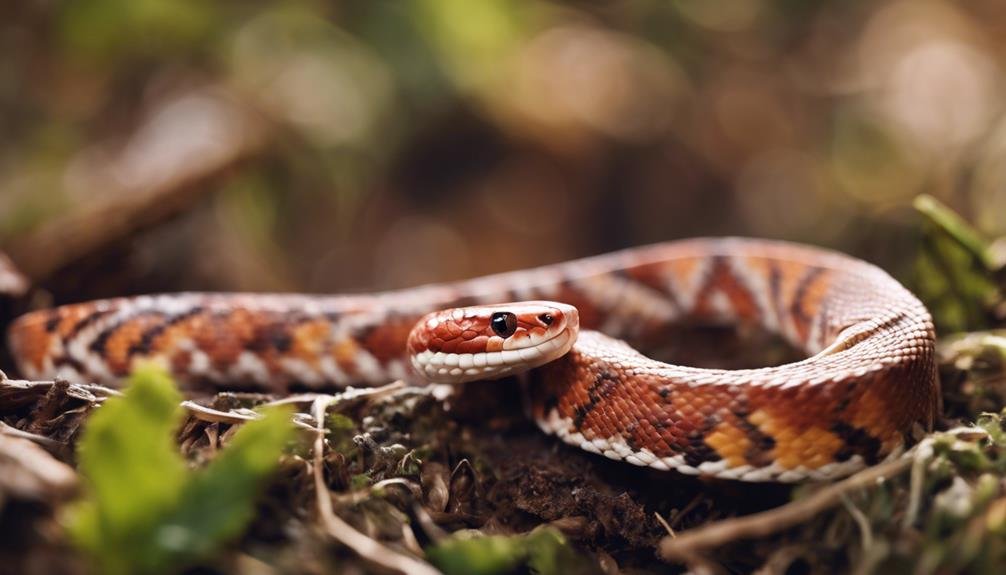

Despite their popularity, you should know that aspen shavings may release volatile oils harmful to your corn snake’s health. These oils can irritate the respiratory system, particularly in snakes with sensitive airways. The risk of respiratory issues is a significant concern, as these problems can be challenging to treat in reptiles and may lead to long-term health complications.
Additionally, the same oils responsible for respiratory discomfort can also cause skin irritation. This means your corn snake might experience discomfort and potentially more severe skin problems over time.
Considering these drawbacks, it’s generally advised to avoid using aspen shavings as a substrate for corn snakes. The propensity for skin and respiratory issues to develop increases with prolonged exposure to these volatile oils. While aspen shavings might seem like a convenient and absorbent option for your snake’s habitat, the potential health risks they pose can’t be overlooked.
Your priority should be creating a safe, comfortable environment for your pet, and unfortunately, aspen shavings mightn’t align with this goal due to their inherent risks.
Coconut Fiber: Advantages
Coconut fiber offers a natural and eco-friendly substrate choice for your corn snake, enhancing both the enclosure’s humidity and aesthetic appeal. Made from coconut husks, this substrate isn’t only important but also kind to the planet. It excels in holding moisture, which is vital for maintaining the right humidity levels inside your snake’s home. This is especially significant for corn snakes, as proper humidity helps in shedding and overall health.
Moreover, coconut fiber allows for natural burrowing behavior. Corn snakes, by nature, love to dig and hide, and this substrate supports that instinct, promoting both mental and physical well-being. It’s an excellent way to make sure your snake feels secure and entertained in its environment.
Another significant advantage is its low dust content. Unlike other substrates that can be dusty and potentially lead to respiratory issues, coconut fiber is much cleaner. This reduces the risk of your snake developing respiratory problems, creating a healthier habitat.
Lastly, many owners find the natural look of coconut fiber aesthetically pleasing. It adds a touch of the wild to the terrarium, creating a visually appealing setup that mimics your corn snake’s natural habitat.
Coconut Fiber: Limitations
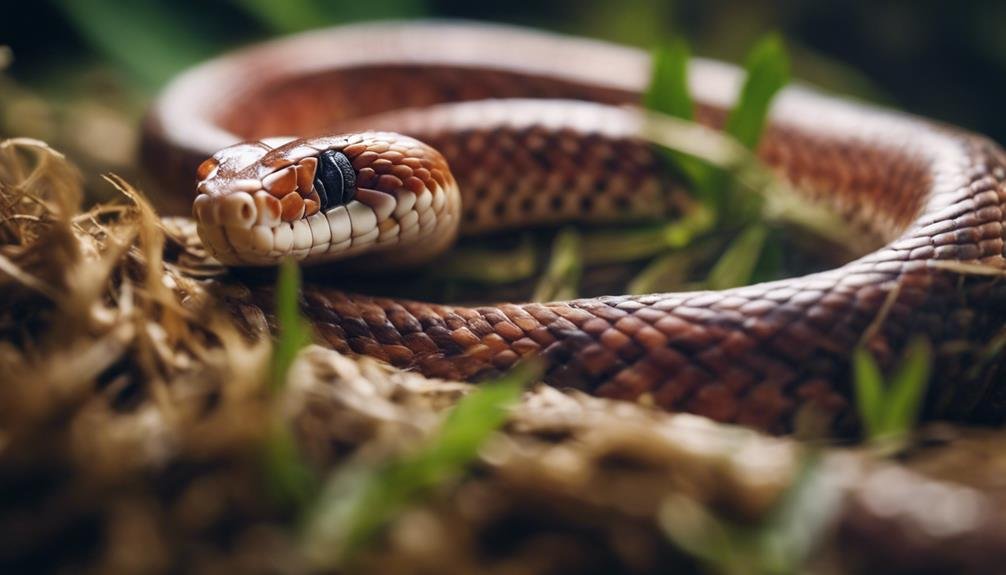

While coconut fiber has its perks, you’ll find it’s not without its drawbacks for your corn snake’s habitat.
It holds moisture well, but this can lead to a higher risk of mold growth, which isn’t ideal for your snake’s health.
Additionally, if ingested, it could cause digestion obstruction, and its high moisture retention capability may not always be beneficial, depending on your specific setup.
Mold Growth Risk
Often, using coconut fiber as a substrate for corn snakes leads to a heightened risk of mold growth due to its tendency to retain excessive moisture. This excessive moisture can create a favorable environment for mold spores, posing several risks:
- Mold growth can directly contribute to respiratory issues in corn snakes, compromising their health.
- The dampness associated with coconut fiber can foster the spread of skin infections, another concern for your pet’s well-being.
- Regular monitoring and adjustments to humidity levels become necessary to prevent mold proliferation, adding to your maintenance tasks.
Considering these points, while coconut fiber has its advantages as one of the substrates for Corn snakes, its propensity for causing mold growth and subsequent respiratory issues can’t be overlooked. Adjusting ventilation or combining it with other substrates might help mitigate these risks.
Digestion Obstruction Concern
Another limitation of using coconut fiber as a substrate for corn snakes is its potential to cause digestion obstructions if ingested. The fibrous nature of coconut fiber can lead to blockages in the snake’s digestive system, posing a significant risk.
Corn snakes may accidentally ingest this substrate while striking at prey or during their explorations within the enclosure. Once ingested, coconut fiber can form clumps within the snake’s digestive tract, causing significant health issues that might require veterinary intervention.
It’s important to monitor the use of coconut fiber as a substrate closely and consider alternative options. This caution helps prevent the risk of digestion obstruction, ensuring your corn snake remains healthy and happy in its environment.
Moisture Retention Capability
Coconut fiber’s ability to retain moisture makes it a preferred choice for regulating humidity in your corn snake’s enclosure. However, this substrate isn’t without its limitations. Despite its excellent moisture retention, you’ll need to keep an eye on a few potential issues:
- Compaction: Over time, coconut fiber can compact, reducing its effectiveness in holding moisture.
- Mold Growth: The high moisture retention can unfortunately create conditions conducive to mold or mildew growth if not properly managed.
- Maintenance: To prevent compaction and maintain its moisture retention capabilities, you’ll need to regularly fluff and aerate the coconut fiber bedding.
While coconut fiber is great for humidity control, its tendency to compact and the risk of mold growth are important considerations for maintaining a healthy and comfortable environment for your corn snake.
Cypress Mulch: Why It Works
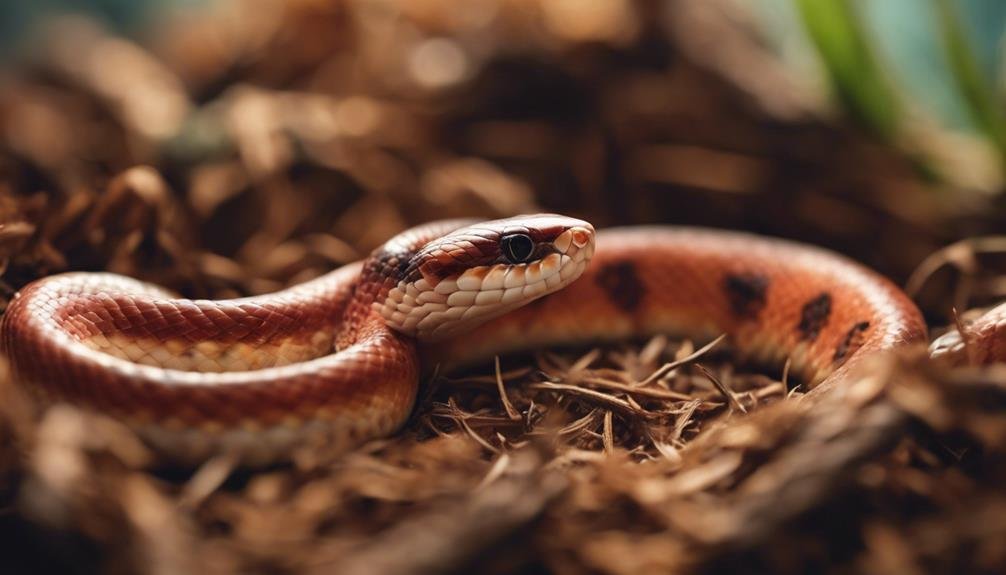

Cypress mulch stands out as an excellent substrate for corn snakes due to its ability to mimic their natural habitat. Made from shredded cypress trees, this natural substrate brings a slice of the forest into your pet’s enclosure, providing a comfortable and familiar environment. It’s particularly praised for its capability to maintain humidity levels, which is essential for your corn snake’s hydration and smooth shedding process. You won’t have to worry about your snake’s skin health when using cypress mulch.
Moreover, cypress mulch is known for being mold-resistant. This quality makes it a top choice for keeping the enclosure clean and free from harmful bacteria that could endanger your snake’s health. It’s reassuring to know that your pet’s bedding is working to promote a healthier habitat.
This substrate also supports your corn snake’s natural behavior, such as burrowing. They’ll feel secure and at home, digging and nestling into the mulch. Plus, it’s a cost-effective solution that’s easy to find in pet stores or online, making it convenient for you to maintain your snake’s home. With cypress mulch, you’re not just providing a substrate; you’re enhancing your corn snake’s living conditions.
Cypress Mulch: Concerns
You might find that cypress mulch struggles to hold onto moisture, which is important for maintaining your corn snake’s environment at the right humidity level.
This lack of moisture retention can also lead to a higher risk of mold growth, posing another potential health hazard for your pet.
Considering these issues, it’s important to weigh the pros and cons carefully before choosing cypress mulch as your substrate.
Moisture Retention Issues
While cypress mulch is great for retaining moisture, it’s vital to keep an eye on humidity levels to prevent mold growth and protect your corn snake’s health. Cypress mulch’s ability to hold moisture can be a double-edged sword. Too much moisture retention might lead to respiratory issues, making close monitoring a necessity.
Here are a few tips:
- Mix cypress mulch with other substrates to balance moisture levels.
- Guarantee good ventilation in the enclosure to help regulate humidity levels.
- Regularly check the humidity with a hygrometer to prevent it from becoming too high.
Mold Growth Risk
Mold growth in your corn snake’s enclosure, often stemming from damp cypress mulch, can lead to serious health issues if not addressed promptly.
Cypress mulch, while popular for its moisture-retaining qualities, can pose a risk of mold growth in conditions of high humidity or improper maintenance. This mold can contribute to respiratory issues in corn snakes, a scenario you’ll want to avoid.
Regularly monitoring humidity levels and the moisture content of the substrate is essential to prevent mold from taking hold.
Ensuring your snake’s home has proper ventilation and promptly replacing any damp or moldy cypress mulch will also mitigate these risks.
Creating a Bioactive Enclosure
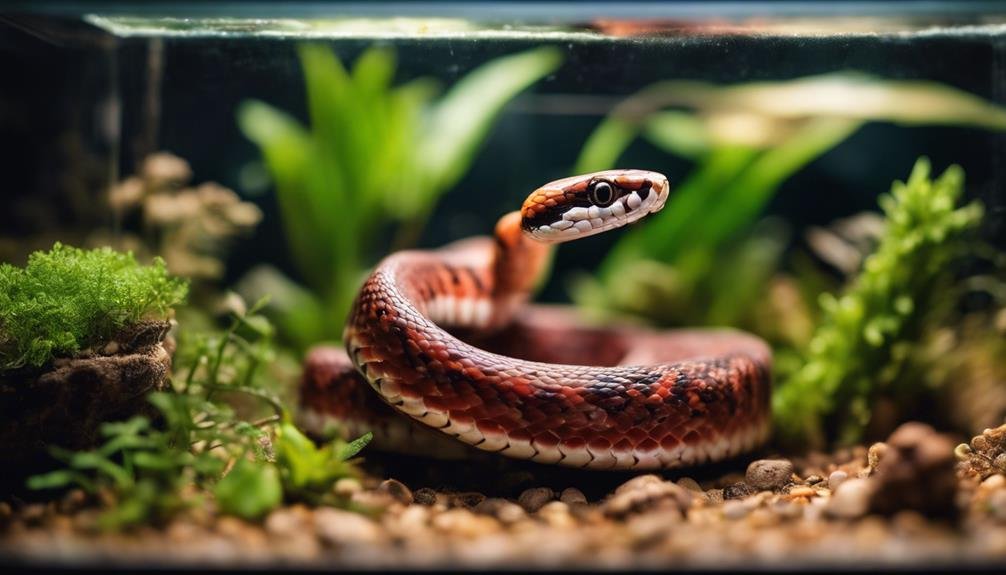

Creating a bioactive enclosure for a corn snake involves integrating a substrate mix that supports a cleanup crew, such as isopods and springtails, to mimic a natural habitat. This approach not only enhances the enclosure’s aesthetics but also provides a more dynamic environment for your snake. By selecting isopods that thrive in moderate humidity levels, you guarantee they remain active and efficient in breaking down waste within the bioactive setup.
Including a layer of leaf litter on top of the substrate mix offers several benefits:
- It serves as a nutritional source for your cleanup crew, keeping them healthy and productive.
- Leaf litter adds to the naturalistic appearance of the habitat, making it more visually appealing.
- This layer helps maintain humidity levels, creating a more comfortable environment for your corn snake.
Is the Best Substrate for Corn Snakes Also Suitable for Incubating their Eggs?
When considering the best substrate for corn snakes, it’s important to choose one that caters to the specific needs of the incubating corn snake eggs process. A suitable substrate helps maintain the necessary temperature and humidity levels for successful egg incubation. It is essential for the health and development of the eggs.
Substrate Maintenance Tips
After setting up your bioactive enclosure, it’s important to keep the substrate clean and healthy for your corn snake. Regular substrate maintenance is vital for preventing bacterial buildup and ensuring the environment remains safe and comfortable for your reptile. Here are some substrate maintenance tips to follow:
| Maintenance Task | Details |
|---|---|
| Spot Clean | Remove feces and soiled areas regularly. |
| Replace Substrate | Do this every 3-4 months to maintain cleanliness. |
| Monitor Humidity | Confirm the substrate is at the correct moisture level. |
| Use Cleanup Crew | Isopods and springtails can break down waste naturally. |
Spot cleaning should be a part of your daily routine to quickly remove feces and any soiled substrate. This helps in preventing the buildup of harmful bacteria and keeps the enclosure smelling fresh. Additionally, replacing the substrate every few months ensures that any accumulated waste or bacteria is completely removed, giving your corn snake a clean slate.
Don’t forget to check the humidity levels frequently. The right moisture level is essential for your corn snake’s health, especially during shedding periods. If you’ve gone for a bioactive setup, adding a cleanup crew like isopods and springtails can greatly reduce the workload by naturally breaking down waste, making your substrate maintenance even easier.
Substrates to Avoid
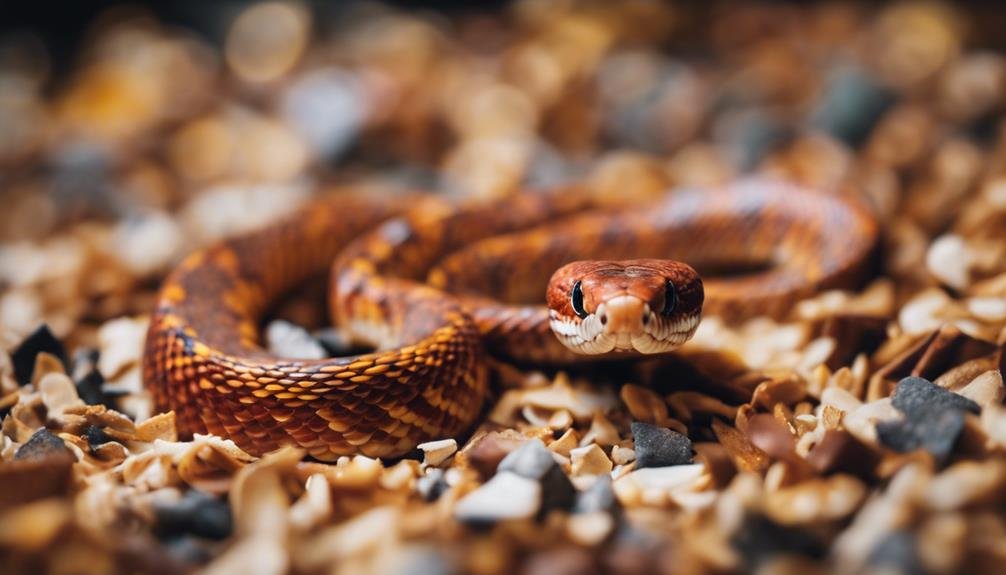

When selecting a substrate for your corn snake, it’s crucial to avoid certain materials that can pose serious health risks. Not all substrates are created equal, and some can be downright dangerous for your slithery friend. To guarantee the well-being of your corn snake, steer clear of the following substrates:
- Pine and Cedar: Both of these materials emit harmful fumes that can lead to respiratory issues in corn snakes. The volatile oils released by pine and cedar shavings are toxic to reptiles and should be avoided at all costs.
- Dusty Materials: Substrates that generate a lot of dust, such as sand, can also cause respiratory problems. These particles can irritate the lungs and airways of your corn snake, leading to discomfort and health issues.
- Gravel: Although it might seem like a good idea for a natural-looking habitat, gravel isn’t a suitable substrate for corn snakes. It can lead to ingestion issues if your snake accidentally swallows it while feeding, potentially causing internal blockages.
Conclusion
Choosing the best substrate for your corn snake boils down to balancing benefits and drawbacks. Aspen shavings offer a burrow-friendly environment but watch out for volatile oils.
Coconut fiber regulates humidity well, yet it’s prone to mold and ingestion risks.
Cypress mulch creates a natural vibe but isn’t the best at retaining moisture. Consider a bioactive enclosure for a self-sustaining option.
Remember, regular maintenance is key, and steer clear of substrates that could harm your snake. Prioritize your pet’s health in your choice.

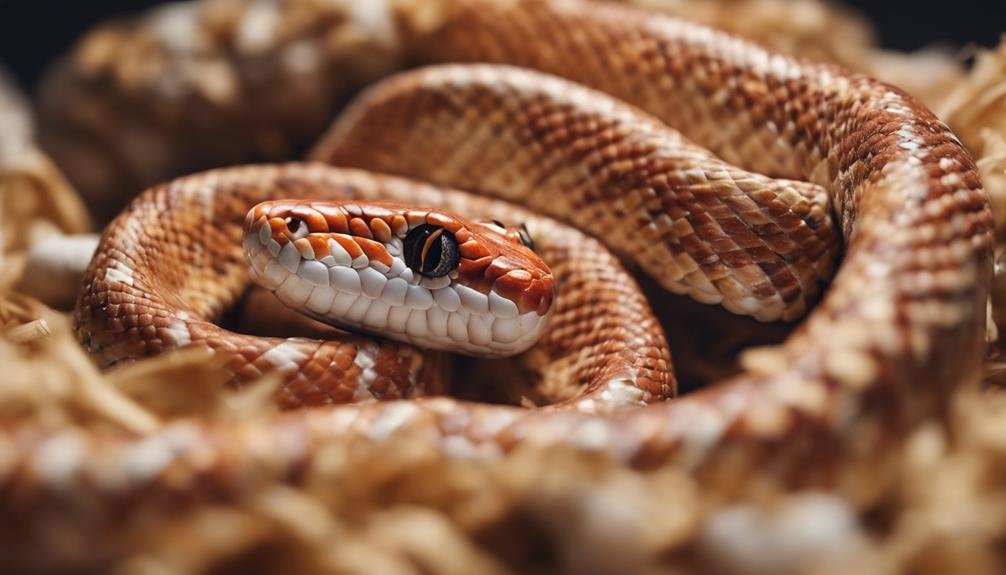

[…] snakes often avoid sand as a substrate because it can cause impaction if ingested. The best substrate for corn snakes is something like aspen shavings or paper towels, which are safer for them to burrow and move […]